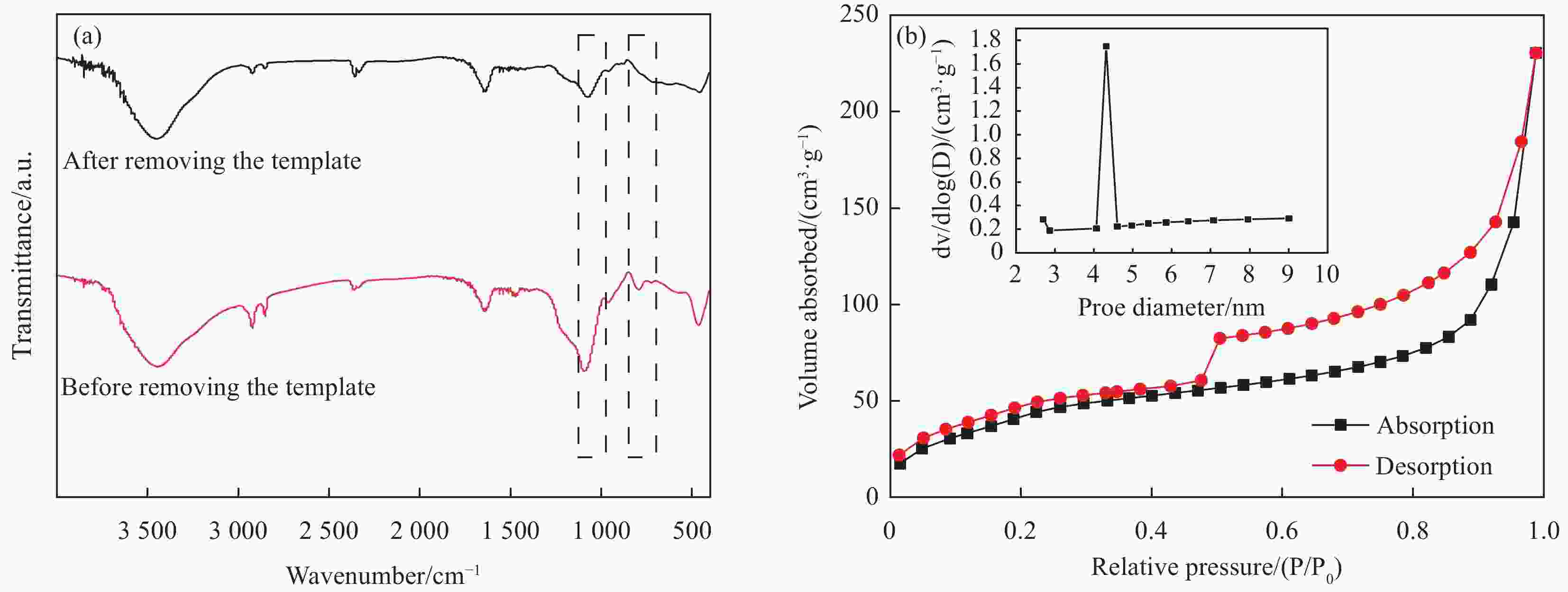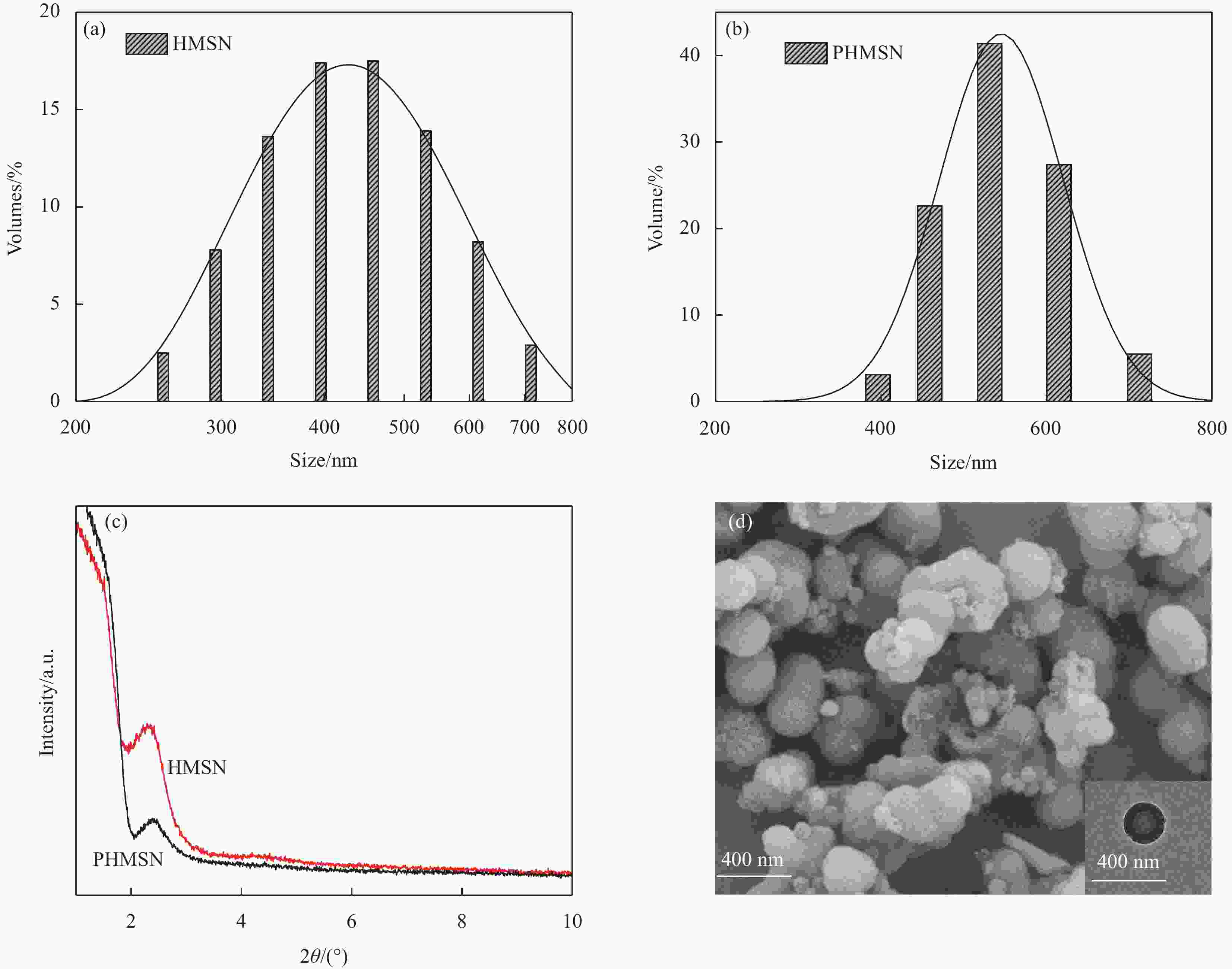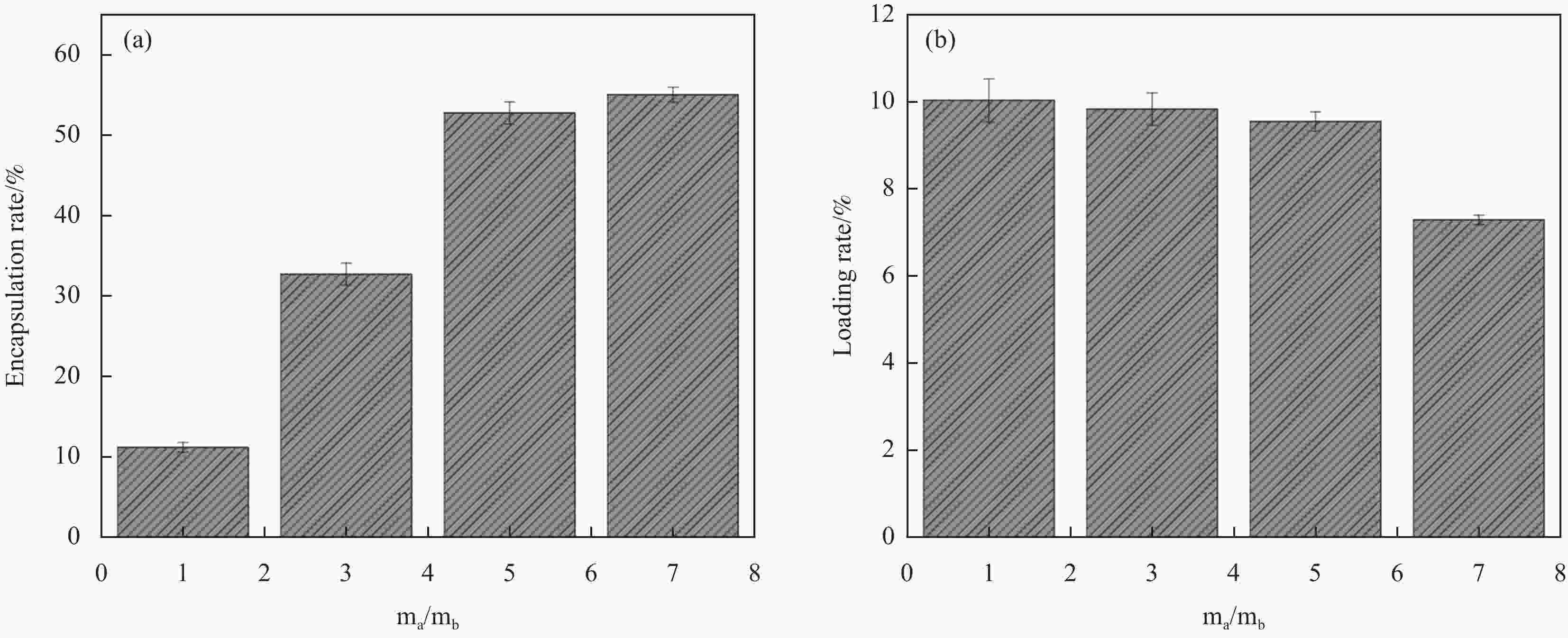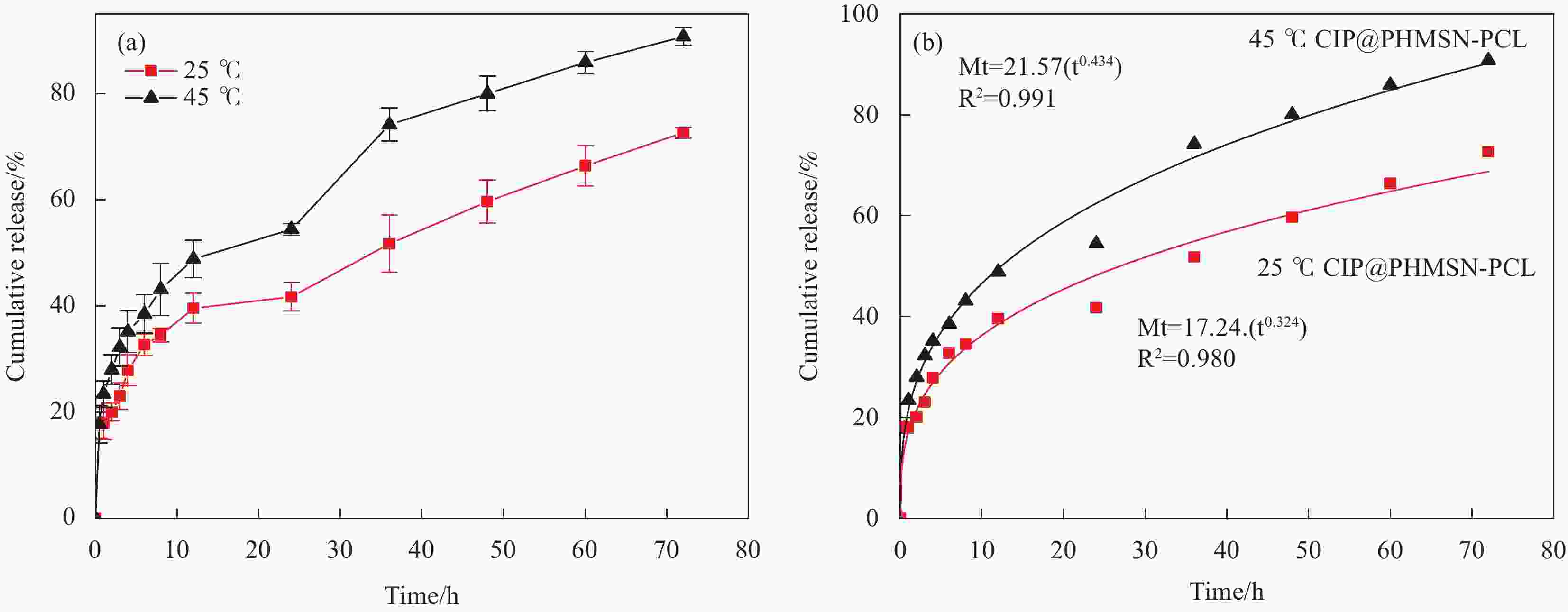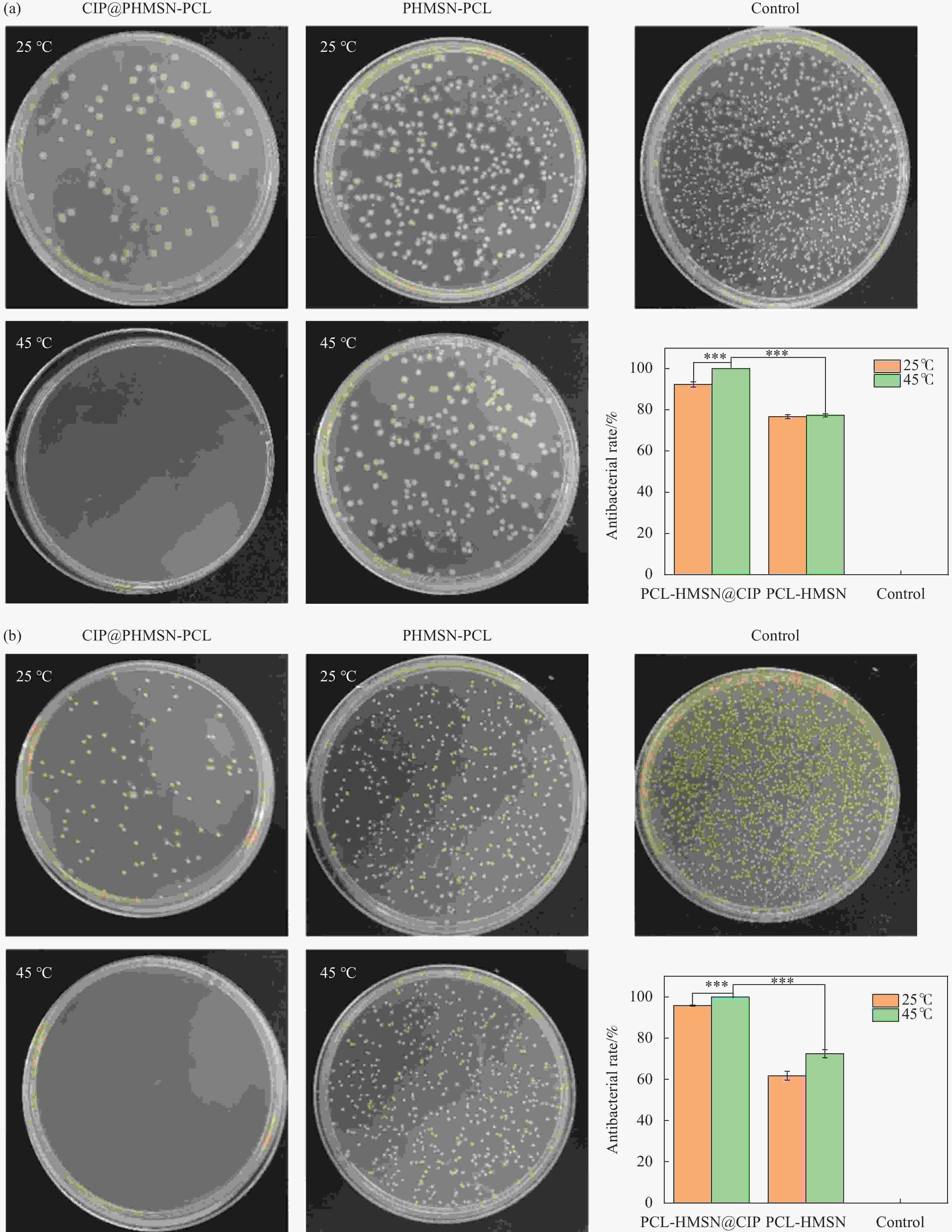Construction and drug release performance of thermosensitive copolymer-modified hollow mesoporous silica and the composite nanofibers
-
摘要: 传统的载药纳米纤维存在药物负载不稳定、释放过快等问题。基于此,本文利用温敏聚合物包覆中空介孔二氧化硅纳米颗粒(HMSN),将其作为药物载体与聚己内酯(PCL)纳米纤维复合,探究了复合纳米纤维膜的释药及抗菌性能。采用自由基聚合方法在HMSN表面接枝异丙基丙烯酰胺与丙烯酰胺的共聚物(P(NIPAM-co-AM)),将疏水性药物环丙沙星(CIP)负载到共聚物改性纳米粒子(PHMSN)中,利用SEM、TEM、TG、比表面积分析(BET)、FTIR及紫外-可见吸收光谱(UV-Vis)等手段表征了HMSN和PHMSN的微观结构和温度响应性能等。将PCL与载药PHMSN共混后利用静电纺丝技术制备了复合纤维膜(CIP@PHMSN-PCL)。CIP@PHMSN-PCL具有温度刺激响应的药物控释功能,在45 ℃和25 ℃下,72 h时CIP的累积释放率分别达到90.78%和72.67%。Korsmeyer-Peppas模型较好地描述了药物释放动力学,表明扩散是复合纤维膜释药的主要机制。45 ℃条件下,载药纤维膜对大肠杆菌(E. coil)和金黄色葡萄球菌(S. aureus)的抑菌率均达到100%;而在25 ℃下,膜对两种菌的抑菌率仅为92.34%和95.83%,证明了不同温度下CIP@PHMSN-PCL膜释药性能的差异。总之,载药PHMSN复合纳米纤维膜具有环境温度调控的释药功能及优异的抗菌活性,在生物医学领域具有潜在的应用价值。Abstract: Traditional drug-loaded nanofibers face challenges such as unstable drug loading and excessively rapid release. In light of these issues, this study employs a thermosensitive copolymer (P(NIPAM-co-AM)) to coat hollow mesoporous silica nanoparticles (HMSN), incorporating them as drug carriers in conjunction with poly(ε-caprolactone) (PCL) nanofibers. The drug release and antibacterial performance of the composite nanofiber membrane were investigated. Firstly, the HMSN surface was functionalized through free radical polymerization by grafting a copolymer of isopropylacrylamide (NIPAM) and acrylamide (AM) (P(NIPAM-co-AM)). Hydrophobic drug ciprofloxacin (CIP) was loaded into the modified nanoparticles (P(NIPAM-co-AM)-HMSN or PHMSN). The analysis of the microstructure, composition, and temperature-responsibility of the drug-loaded particles were performed using SEM, TEM, TG, BET analysis, FTIR, UV-Vis spectroscopy, etc. Blending PCL with drug-loaded PHMSN, a composite fibrous membrane (CIP@PHMSN-PCL) was fabricated using electrospinning. CIP@PHMSN-PCL exhibited temperature-stimulated drug releasing, with cumulative release rates of CIP reaching 90.78% and 72.67% at 45℃ and 25℃ after 72 hours, respectively. The Korsmeyer-Peppas model aptly described the drug release kinetics, suggesting the diffusion as the primary mechanisms for drug release from the composite fiber membrane. At 45℃, the drug-loaded fiber membrane exhibited a 100% inhibition rate against Escherichia coli (E. coli) and Staphylococcus aureus (S. aureus). At 25℃, the inhibition rates were 92.34% and 95.83% against E. coli and S. aureus, respectively, demonstrating temperature-dependent drug release performance of the CIP@PHMSN-PCL membrane. In summary, the drug-loaded PHMSN composite nanofiber membrane exhibits temperature-regulated drug release functionality and excellent antibacterial activity, holding potential application value in the biomedical field.
-
Key words:
- hollow mesoporous silica /
- thermosensitive /
- nanofiber membrane /
- drug release /
- antibacterial
-
表 1 25℃下纤维膜的释药累积量动力学拟合
Table 1. Kinetic fitting of cumulative drug release from fiber membrane at 25℃
Model Equation R2 First-Order Model Mt=59.07(1-e−0.13 t) 0.812 Zero-Order Model Mt=0.79t+20.54 0.862 Higuchi Model Mt=1.58(t1/2)+20.54 0.849 Korsmeyer-Peppas Model Mt=17.24(t0.324) 0.980 Notes:t is the time of release; Mt is the amount of drug released at time t; R2 is the regression coefficients. 表 2 45℃下纤维膜的释药累积量动力学拟合
Table 2. Kinetic fitting of cumulative drug release from fiber membrane at 45℃
Model Equation R2 First-Order Model Mt=78.66 (1-e−0.11 t) 0.848 Zero-Order Model Mt=1.04t+26.05 0.869 Higuchi Model Mt=2.09(t1/2)+26.04 0.858 Korsmeyer-Peppas Model Mt=21.57(t0.434) 0.991 -
[1] WEN J, YANG K, LIU F, et al. Diverse gatekeepers for mesoporous silica nanoparticle based drug delivery systems[J]. Chemical Society Reviews, 2017, 46(19): 6024-6045. doi: 10.1039/C7CS00219J [2] LI Z, BARNES J C, BOSOY A, et al. Mesoporous silica nanoparticles in biomedical applications[J]. Chemical Society Reviews, 2012, 41(7): 2590-2605. doi: 10.1039/c1cs15246g [3] HUANG P, LIAN D, MA H, et al. New advances in gated materials of mesoporous silica for drug controlled release[J]. Chinese Chemical Letters, 2021, 32(12): 3696-3704. doi: 10.1016/j.cclet.2021.06.034 [4] ADHIKARI C, MISHRA A, NAYAK D, et al. Drug delivery system composed of mesoporous silica and hollow mesoporous silica nanospheres for chemotherapeutic drug delivery[J]. Journal of Drug Delivery Science and Technology, 2018, 45: 303-314. doi: 10.1016/j.jddst.2018.03.020 [5] JIN T, WU D, LIU X M, et al. Intra-articular delivery of celastrol by hollow mesoporous silica nanoparticles for pH-sensitive anti-inflammatory therapy against knee osteoarthritis[J]. Journal of Nanobiotechnology, 2020, 18(1): 94-96. doi: 10.1186/s12951-020-00651-0 [6] SAINT-CRICQ P, DESHAYES S, ZINK J I, et al. Magnetic field activated drug delivery using thermodegradable azo-functionalised PEG-coated core–shell mesoporous silica nanoparticles[J]. Nanoscale, 2015, 7(31): 13168-13172. doi: 10.1039/C5NR03777H [7] HAMNER K L, ALEXANDER C M, COOPERSMITH K, et al. Using temperature-sensitive smart polymers to regulate DNA-mediated nanoassembly and encoded nanocarrier drug release[J]. ACS Nano, 2013, 7(8): 7011-7020. doi: 10.1021/nn402214e [8] YU F, WU H, TANG Y, et al. Temperature-sensitive copolymer-coated fluorescent mesoporous silica nanoparticles as a reactive oxygen species activated drug delivery system[J]. International Journal of Pharmaceutics, 2018, 536(1): 11-20. doi: 10.1016/j.ijpharm.2017.11.025 [9] XIONG L, Bi J, TANG Y, et al. Magnetic core–shell silica nanoparticles with large radial mesopores for siRNA delivery[J]. Small, 2016, 12(34): 4735-4742. doi: 10.1002/smll.201600531 [10] ACOSTA C, PÉREZ-ESTEVE E, FUENMAYOR C A, et al. Polymer composites containing gated mesoporous materials for on-command controlled release[J]. ACS Applied Materials & Interfaces, 2014, 6(9): 6453-6460. [11] PARK C, KIM H, KIM S, et al. Enzyme responsive nanocontainers with cyclodextrin gatekeepers and synergistic effects in release of guests[J]. Journal of the American Chemical Society, 2009, 131(46): 16614-16615. doi: 10.1021/ja9061085 [12] BOISSENOT T, BORDAT A, FATTAL E, et al. Ultrasound-triggered drug delivery for cancer treatment using drug delivery systems: From theoretical considerations to practical applications[J]. Journal of Controlled Release, 2016, 241: 144-163. doi: 10.1016/j.jconrel.2016.09.026 [13] PARIS J L, CABAÑAS M V, MANZANO M, et al. Polymer-grafted mesoporous silica nanoparticles as ultrasound-responsive dug carriers[J]. ACS Nano, 2015, 9(11): 11023-11033. doi: 10.1021/acsnano.5b04378 [14] LIN H M, Wang W K, HSIUNG P A, et al. Light-sensitive intelligent drug delivery systems of coumarin-modified mesoporous bioactive glass[J]. Acta Biomaterialia, 2010, 6(8): 3256-3263. doi: 10.1016/j.actbio.2010.02.014 [15] ABDOLLAHI A, SAHANDI-ZANGABAD K, ROGHANI-MAMAQANI H. Light-induced aggregation and disaggregation of stimuli-responsive latex particles depending on spiropyran concentration: kinetics of photochromism and investigation of reversible photopatterning[J]. Langmuir, 2018, 34(46): 13910-13923. doi: 10.1021/acs.langmuir.8b02296 [16] HAJEBI S, ABDOLLAHI A, ROGHANI-MAMAQANI H, et al. Temperature-responsive Poly(N-Isopropylacrylamide) nanogels: The role of hollow cavities and different shell cross-linking densities on doxorubicin loading and release[J]. Langmuir, 2020, 36(10): 2683-2694. doi: 10.1021/acs.langmuir.9b03892 [17] PERALTA M E, JADHAV S A, MAGNACCA G, et al. Synthesis and in vitro testing of thermoresponsive polymer-grafted core-shell magnetic mesoporous silica nanoparticles for efficient controlled and targeted drug delivery[J]. Journal of Colloid and Interface Science, 2019, 544: 198-205. doi: 10.1016/j.jcis.2019.02.086 [18] GANDHI A, PAUL A, SEN S O, et al. Studies on thermoresponsive polymers: Phase behaviour, drug delivery and biomedical applications[J]. Asian Journal of Pharmaceutical Sciences, 2015, 10(2): 99-107. doi: 10.1016/j.ajps.2014.08.010 [19] ZHANG Z, WANG S, WATERHOUSE G I N, et al. Poly(N-isopropylacrylamide)/mesoporous silica thermosensitive composite hydrogels for drug loading and release[J]. Journal of Applied Polymer Science, 2019, 137(8): 48391. [20] SAEED A, GEORGET D M R, MAYES A G. Synthesis, characterisation and solution thermal behaviour of a family of poly (N-isopropyl acrylamide-co-N-hydroxymethyl acrylamide) copolymers[J]. Reactive and Functional Polymers, 2010, 70(4): 230-237. doi: 10.1016/j.reactfunctpolym.2009.12.004 [21] CUI Z, LEE B H, PAUKEN C, et al. Degradation, cytotoxicity, and biocompatibility of NIPAAm-based thermosensitive, injectable, and bioresorbable polymer hydrogels[J]. Journal of Biomedical Materials Research Part A, 2011, 98A(2): 159-166. doi: 10.1002/jbm.a.33093 [22] GAO Y, PEI W, YANG Y, et al. Multifunctional nanofibrous mats: toward antibacterial and anti-inflammatory applications, and visual bacterial diagnosis[J]. Journal of Materials Chemistry B, 2023, 11(33): 8046-8055. doi: 10.1039/D3TB01235B [23] 段红梅, 汪希铭, 黄子欣, 等. 纤维基介孔SiO2药物载体的构建及其释药性能[J]. 纺织学报, 2020, 41(7): 15-22.DUAN Hongmei, WANF Ximing, HUANG Zixin, et al. Construction of fiber-based mesoporous SiO2 drug carrier and its drug release performance[J]. Journal of Textile Research, 2020, 41(7): 15-22(in Chinese). [24] CHEN Y, CHEN H, GUO L, et al. Hollow/rattle-type mesoporous nanostructures by a structural difference-based selective etching strategy[J]. ACS Nano, 2010, 4(1): 529-539. doi: 10.1021/nn901398j [25] YAN Y, LIU Y, LI J, et al. A molecular switch-integrated nanoplatform enables photo-unlocked antibacterial drug delivery for synergistic abscess therapy[J]. Advanced Healthcare Materials, 2023, 12(27): 2301157. doi: 10.1002/adhm.202301157 [26] LI T, GENG T, Md A, et al. Novel scheme for rapid synthesis of hollow mesoporous silica nanoparticles (HMSNs) and their application as an efficient delivery carrier for oral bioavailability improvement of poorly water-soluble BCS type II drugs[J]. Colloids and Surfaces B:Biointerfaces, 2019, 176: 185-193. doi: 10.1016/j.colsurfb.2019.01.004 [27] ZHU Y, ZHANG M, WEI S, et al. Temperature-responsive P(NIPAM-co-NHMA)-grafted organic-inorganic hybrid hollow mesoporous silica nanoparticles for controlled drug delivery[J]. Journal of Drug Delivery Science and Technology, 2022, 70: 103197. doi: 10.1016/j.jddst.2022.103197 [28] WU M X, WANG X, YANG Y W. Polymer nanoassembly as delivery systems and anti-bacterial toolbox: from PGMAs to MSN@PGMAs[J]. The Chemical Record, 2017, 18(1): 45-54. [29] WEi Z, ZHAO W, WANG Y, et al. Novel PNIPAm-based electrospun nanofibres used directly as a drug carrier for “on-off” switchable drug release[J]. Colloids and Surfaces B:Biointerfaces, 2019, 182: 110347. doi: 10.1016/j.colsurfb.2019.110347 [30] CUELLO N I, ELÍAS V R, MENDIETA S N, et al. Drug release profiles of modified MCM-41 with superparamagnetic behavior correlated with the employed synthesis method[J]. Materials Science and Engineering:C, 2017, 78: 674-681. doi: 10.1016/j.msec.2017.02.010 [31] XIAO S, YUAN L, LIU J, et al. Vancomycin-loaded silica coatings for controlled release of drug and Si ions to repair infected bone defects[J]. Surface and Coatings Technology, 2023, 463: 129525. doi: 10.1016/j.surfcoat.2023.129525 [32] HUAN Y, KONG Q, TANG Q, et al. Antimicrobial peptides/ciprofloxacin-loaded O-carboxymethyl chitosan/self-assembling peptides hydrogel dressing with sustained-release effect for enhanced anti-bacterial infection and wound healing[J]. Carbohydrate Polymers, 2022, 280: 119033. doi: 10.1016/j.carbpol.2021.119033 -

 点击查看大图
点击查看大图
计量
- 文章访问数: 128
- HTML全文浏览量: 91
- 被引次数: 0




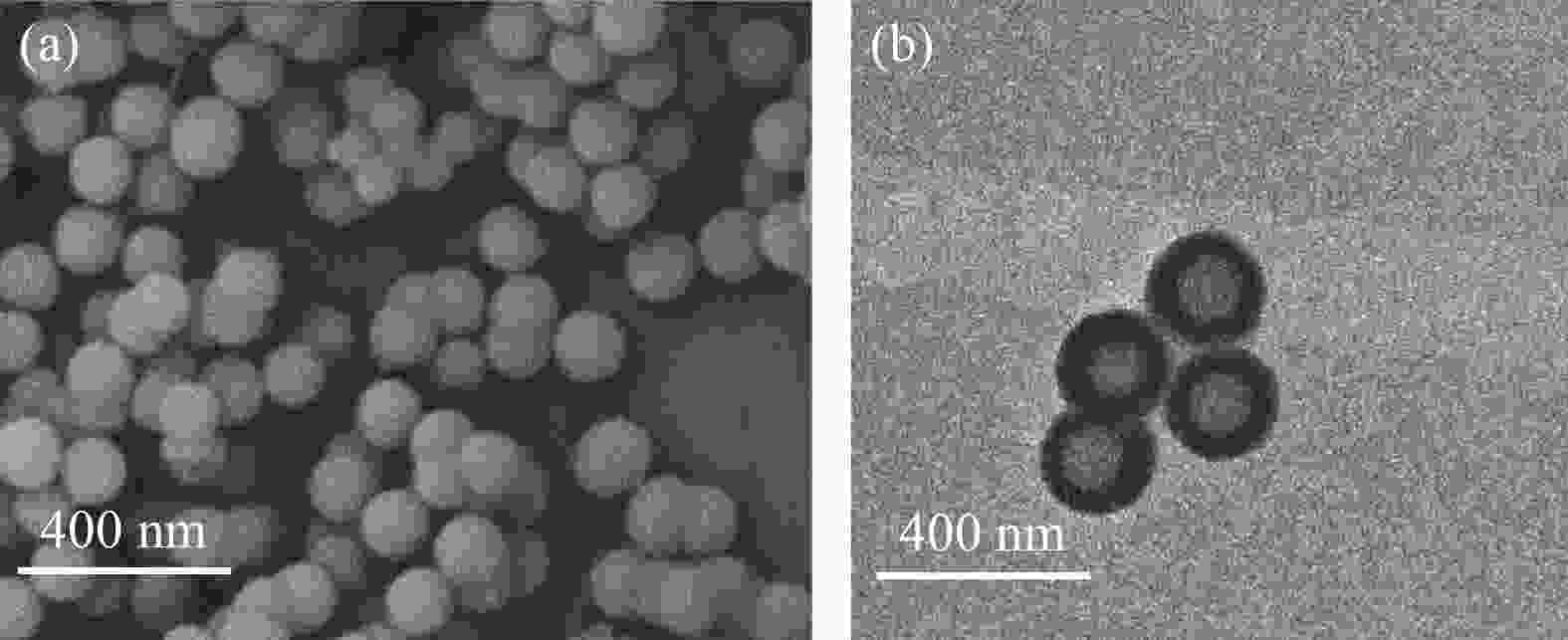
 下载:
下载:
